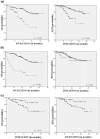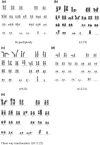Evaluation of Cytogenetic Abnormalities in Patients with Acute Lymphoblastic Leukemia
- PMID: 31741615
- PMCID: PMC6825071
- DOI: 10.1007/s12288-019-01123-8
Evaluation of Cytogenetic Abnormalities in Patients with Acute Lymphoblastic Leukemia
Abstract
Acute lymphoblastic leukemia (ALL) accounts for 20% of all adult leukemias and is the most common leukemia during childhood (80%). We present data on cytogenetics of ALL from a tertiary centre in India correlating it with clinical factors. Karyotyping of bone marrow samples of 204 patients with newly diagnosed ALL was performed with standard G-banding technique. Clinical data of patients was obtained from case records. Survival was estimated using Kaplan-Meir curves and compared by the log-rank test. Univariate and multivariate analysis was done for survival with age, sex, immunophenotype, hyperleukocytosis, risk type, remission status and cytogenetics. The most common karyotypes observed were normal in 39.7% (N = 81), hyperdiploidy in 12.7% (N = 26), t(9;22) in 4.4% (N = 9), t(1;19) in 3.9% (N = 8). Adults with ALL had worse survival compared with pediatric patients (HR 3.62; 2.03-6.45 95% CI, p < 0.001). Patients not in morphologic remission after induction chemotherapy fared poorly (HR 4.86; 2.67-8.84 95% CI, p < 0.001). Patients with favourable cytogenetics had better overall survival (HR 0.36; 0.12-1.05 95% CI, p < 0.05). On multivariate analysis, achievement of morphologic remission emerged as single most significant predictor of survival (p < 0.001). MLL gene rearrangement and t(12;21) were seen less commonly as compared to Western data. However, incidence rates of various cytogenetic abnormalities were similar to that reported from other centres from India. Age, morphologic remission at end of induction chemotherapy and favourable cytogenetics correlated significantly with survival.
Keywords: Acute lymphoblastic leukemia; Cytogenetics; India; Karyotype; Overall survival.
© Indian Society of Hematology and Blood Transfusion 2019.
Conflict of interest statement
Conflict of interestThe authors declare that they have no conflict of interest.
Figures


References
LinkOut - more resources
Full Text Sources
